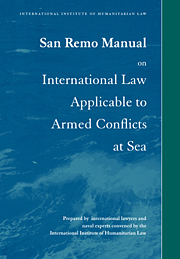 San Remo Manual on International Law Applicable to Armed Conflicts at Sea
San Remo Manual on International Law Applicable to Armed Conflicts at Sea Book contents
FOREWORD
Published online by Cambridge University Press: 04 August 2010
Summary
The International Institute of Humanitarian Law, at the initiative of its President, Professor J. Patrnogic, Professor N. Ronzitti from the University of Pisa (Italy) and Professor A. Goldie from the University of Syracuse (USA), began in 1987 a series of meetings of international lawyers and naval experts on the subject of the need for a modernisation of the law applicable to armed conflict at sea. At the second meeting, the experts suggested to the Institute that they work on the development of a manual. The intensive work over the following years led to the adoption of the San Remo Manual.
This document is a contemporary restatement of the law, together with some progressive development, which takes into account recent State practice, technological developments and the effect of related areas of the law, in particular, the United Nations Charter, the 1982 Law of the Sea Convention, air law and environmental law. The last restatement of the law of armed conflict at sea was undertaken by the Institute of International Law in 1913. Developments in the law since that date have for the most part not been incorporated into treaty law, with the exception of the Second Geneva Convention which is essentially limited to the protection of the wounded, sick and shipwrecked at sea, and does not address the whole question of the law on the conduct of hostilities at sea. The Manual and the related Explanation represent a unique effort of experts from different parts of the world to establish the present state of the law based on State practice and treaty law of continuing validity.
- Type
- Chapter
- Information
- San Remo Manual on International Law Applicable to Armed Conflicts at SeaInternational Institute of Humanitarian Law, pp. ix - xPublisher: Cambridge University PressPrint publication year: 1995
- 2
- Cited by


